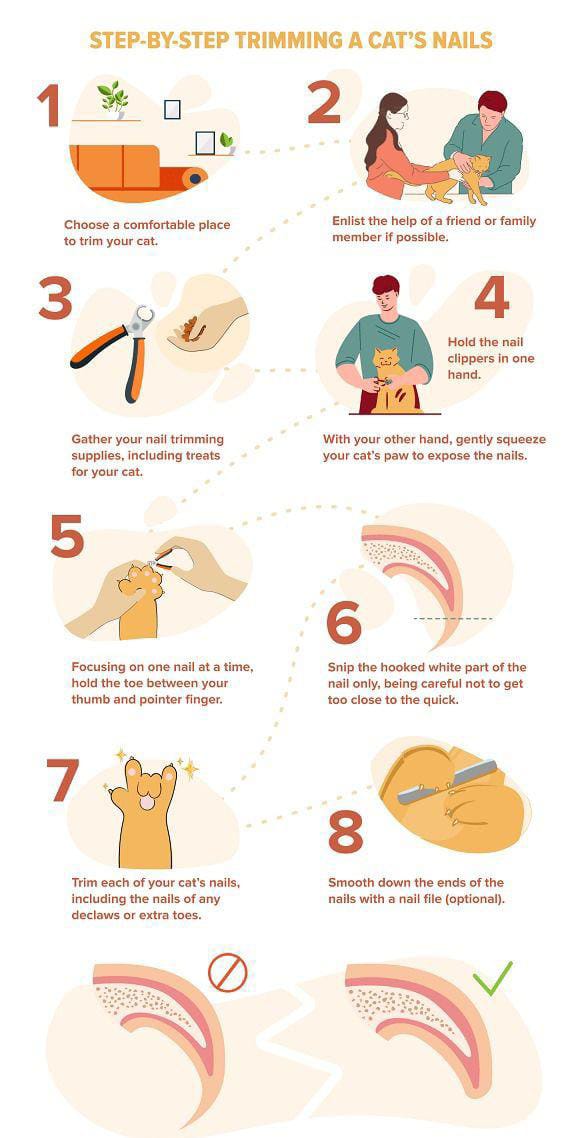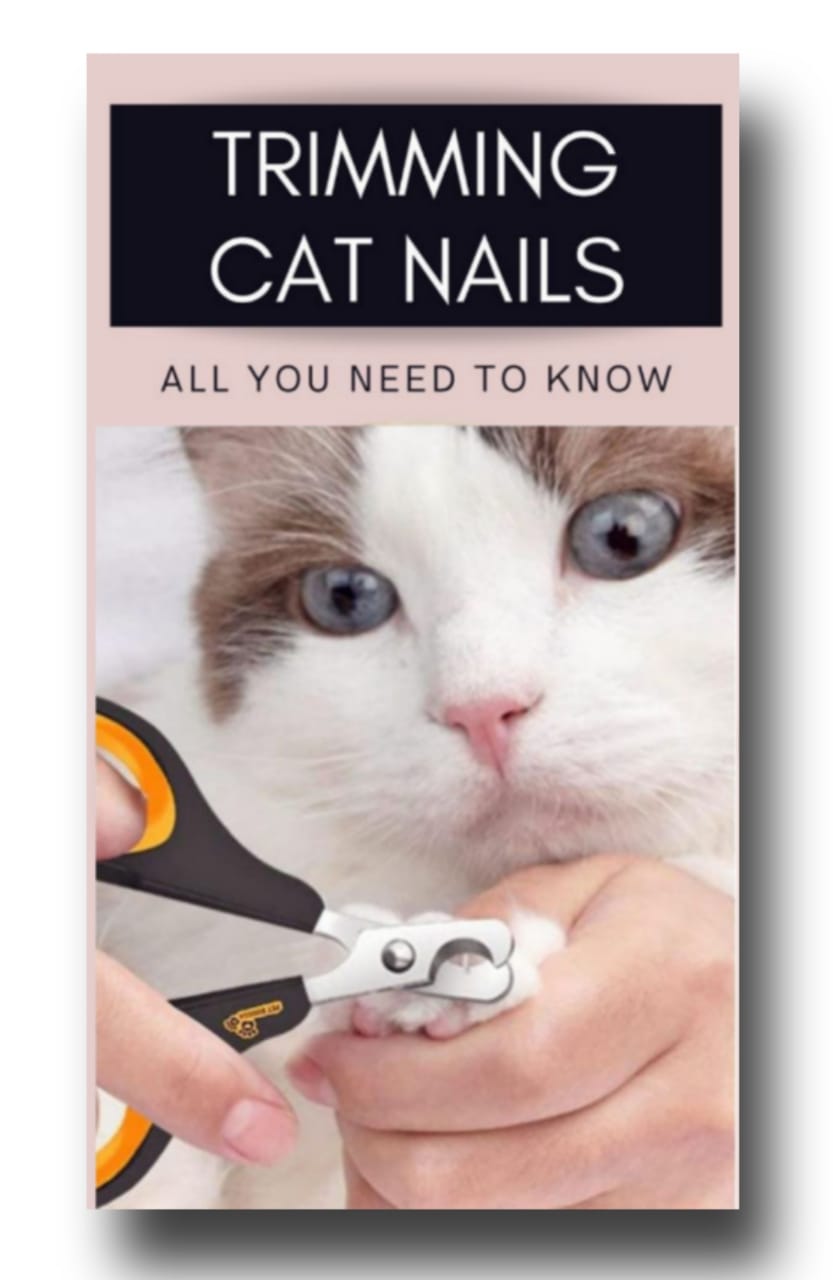Trim Cat Nails at Home
Ever felt like you’re going to war every time you try to trim your cat’s nails? You’re not alone. Many cat owners feel the same. But here’s the thing: trimming your cat’s nails is not only important—it’s totally doable at home with the right approach. And no, you don’t need a vet degree to pull it off.
How Fast Do Cat Nails Grow – Most cats’ nails grow every 2–3 weeks. Indoor cats especially need regular trimming since they don’t wear them down like outdoor cats do.
What Happens If You Don’t Trim Them – Long nails can curl into the paw pad, causing pain, infection, or even difficulty walking. They also increase the risk of accidental scratches to you, your kids, or your furniture.
Signs Your Cat’s Nails Need Trimming
1. You hear clicking when your cat walks
2. They get snagged on fabric or carpet
3. They start scratching furniture more often
“Read – How to Bathe a Dog & Cat at Home”
Ideally, every 2–4 weeks. It depends on the age, activity level, and whether your cat is indoor or outdoor.
Step-by-Step Guide to Trim Cat Nails At Home
Step 1: Position Your Cat Properly – Hold your cat in your lap or place them on a table. Some cats do better wrap in a towel burrito-style with one paw exposed.
Step 2: Gently Press the Paw – Press gently on the paw pad and top of the paw to extend the claws.
Step 3: Identify the Quick – Look for the pinkish area inside the nail—don’t cut it. Aim to clip just the sharp white tip.
Step 4: Trim Just the Tip – Make a quick, clean snip. If your cat flinches or jerks, stop and soothe them.
Step 5: Reward and Praise – Give a treat, pet them, and make it a positive experience. This builds cooperation over time.
“Read – How Pet Nails Shiny At Home”

The Best Way to Trim Cat Nails Using Clippers
Trimming your cat’s nails with clippers may sound intimidating, especially if your feline friend is a little fussy. But with the right technique and mindset, it can become a quick and stress-free part of your grooming routine. Here’s the best way to trim cat nails using clippers — safely and confidently.
1. Choose the Right Clippers – Not all clippers are created equal. For cat nails, scissor-style clippers are highly recommended. They’re precise, easy to handle, and designed for small paws. Guillotine-style clippers can work too, but they’re better suited for experienced users. Whatever you use, make sure the blades are sharp to prevent nail splitting.
2. Get Your Cat Comfortable – Pick a calm time — after a nap or play session is ideal. Use a soft blanket or towel to gently wrap your cat if they tend to squirm. This helps them feel secure and keeps you safe from sudden claw attacks.
3. Examine the Paw Gently – Hold your cat’s paw and press softly on the pad to extend the nails. Look for the “quick” — the pink section inside the nail. This is a bundle of nerves and blood vessels. Avoid cutting it, as it can cause pain and bleeding.
4. Trim Just the Tip – Using your clippers, cut only the sharp, white tip of the nail. Aim for a quick, clean snip. If you’re unsure, it’s safer to trim less than too much. Repeat for each nail & remember. it’s okay to do one paw at a time if your cat gets impatient.
5. Stay Calm and Reward – Speak in a soft voice & stay relaxed. Cats feed off your energy. After trimming, reward your kitty with treats, praise, or gentle cuddles. This helps them associate nail trims with positive outcomes.
Useful tips – Keep Styptic Powder Handy – Accidents happen. If you accidentally cut the quick and it bleeds, apply styptic powder or cornstarch to stop the bleeding. Don’t panic — just pause, soothe your cat, and try again another day.
“the best way to trim cat nails with clippers is with patience, the right tools, and a lot of love. Over time, both you and your cat will become more comfortable with the routine — and your furniture (and skin!) will thank you.”
Prepping Your Cat for Nail Trimming
Create a Calm Environment – Choose a quiet room where your cat feels comfortable. Avoid loud noises and distractions.
Get Your Cat Used to Paw Handling – Start gently touching your cat’s paws daily for a few seconds. Reward with treats. These builds trust over time.
Choose the Right Time – Trim nails when your cat is relaxed or sleepy—like after a meal or play session.
Top 5 important Tools That Help in Cat Nail Trimming
Trimming your cat’s nails at home doesn’t have to be stressful — if you have the right tools. The correct equipment can make all the difference between a smooth, quick trim and a chaotic mess. Here are five essential tools that help make cat nail trimming easier, safer, and more effective.
1. Cat Nail Clippers – This is the most important tool in your kit. There are two main types of cat nail clippers:
Scissor-style clippers are easy to handle and perfect for beginners.
Guillotine-style clippers offer more precision but may need practice.
Always choose a sharp, high-quality clipper made for small pets. Dull blades can crush the nail instead of cutting it, which may cause discomfort.
2. Nail File or Emery Board – After trimming, some nails may have sharp or rough edges. A nail file helps smooth them out, preventing scratches or accidental snags on furniture. It’s especially useful if you didn’t get a clean cut or your cat is very active.
3. Styptic Powder or Gel – Even the most careful cat owner can accidentally nick the quick (the sensitive inner part of the nail). That’s where styptic powder comes in — it stops bleeding quickly and eases pain. Keep this in your grooming kit as a backup. If you don’t have styptic powder, cornstarch can work in an emergency.
4. Cat Treats – Technically not a “tool,” but absolutely essential. Treats help create a positive association with nail trims. Reward your cat after each paw or even each nail to build trust and reduce anxiety over time.
5. Towel or Blanket – A soft towel or blanket can help secure your cat if they squirm. Wrap them gently in a “cat burrito,” leaving one paw out at a time. This prevents sudden movements and keeps your kitty calm during the trim.
Avoid Common Mistakes in Cat Nail Trimming
Trimming your cat’s nails may seem simple, but one wrong move can turn a calm grooming session into a struggle. Many cat owners unknowingly make small mistakes that lead to stress for both them and their feline friends. To keep your cat safe and comfortable, it’s important to avoid these common nail-trimming pitfalls.
1. Trimming Too Close to the Quick – The biggest mistake cat owners make is cutting the nail too short. Inside each claw is the “quick,” a pinkish area filled with nerves and blood vessels. Accidentally cutting into the quick is painful for your cat and can cause bleeding. Always trim just the sharp white tip of the nail, and if you’re unsure, it’s better to cut less.
2. Using the Wrong Clippers – Using dull or inappropriate clippers is another common error. Human nail clippers can crush or split a cat’s nail, especially in adult cats. Instead, use sharp, cat-specific clippers—either scissor or guillotine-style. A good clipper ensures a clean cut and makes the process smoother.
3. Rushing the Process – Cats don’t like being rushed. If you try to trim all their nails in one go, especially if they’re anxious, it can backfire. Instead, take your time. Do one paw at a time, or even a few nails per session. The goal is to keep your cat calm and cooperative.
4. Not Creating a Calm Environment – Trimming in a noisy or chaotic space can stress your cat. Choose a quiet, comfortable area where your cat feels safe. Some cats respond well to being gently wrapped in a towel (like a burrito), exposing one paw at a time. This adds comfort and limits movement.
5. Skipping the Positive Reinforcement – One of the easiest mistakes to fix? Forgetting to reward your cat. Treats, petting, or playtime after trimming builds trust and helps your cat associate the experience with something pleasant. This makes future trims much easier.
6. Waiting Too Long Between Trims – Ignoring your cat’s nails until they’re overgrown can make trimming harder and more painful. Regular trimming every 2–4 weeks keeps the nails manageable and prevents problems like curling or breaking.
“Read – How Pet Nails Shiny At Home”
What to Do If Your Cat’s Nail Bleeds After Trimming
Accidentally cutting your cat’s nail too short can cause bleeding, especially if you clip into the quick — the sensitive, pink part inside the nail that contains blood vessels and nerves. While it’s a common mistake, especially for beginners, knowing what to do can help you handle the situation calmly and protect your cat from pain or infection. Here’s what you should do if your cat’s nail bleeds after trimming:
1. Stay Calm and Comfort Your Cat – First things first — don’t panic. A bleeding nail can look scary, but it usually isn’t serious. Speak softly to your cat and gently hold them to prevent them from running away or licking the area too much. Your calm energy will help soothe your pet.
2. Apply Styptic Powder or Cornstarch – The best way to stop the bleeding is to apply styptic powder directly to the tip of the nail. It works quickly to clot the blood and ease any pain. If you don’t have styptic powder, you can use cornstarch or baking flour as a temporary solution. Just press a small amount onto the bleeding area with your finger or a cotton swab.
3. Apply Gentle Pressure – If the bleeding doesn’t stop right away, apply gentle pressure using a clean cloth or gauze. Hold it in place for a few minutes. This helps slow the bleeding and gives the clotting agents time to work.
4. Keep the Paw Clean – Once the bleeding stops, make sure the paw stays clean. Don’t let your cat walk on dirty surfaces or lick the wound excessively. If needed, keep them indoors for the day or gently wrap the paw for a short time.
5. Monitor for Signs of Infection – Watch the nail over the next few days. If you notice swelling, continued bleeding, pus, or your cat limping, contact your vet — it could be a sign of infection or deeper injury.
“READ TRANDING Ai TOOLS TOPIC “
3 Common Myths About Cat Nail Trimming
Cats don’t need nail trims – False. Especially indoor cats do!
It hurts them – Not if done correctly.
Declawing is better – Never! It’s painful and cruel. Regular trims are the humane option.
Overall – Trimming your cat’s nails doesn’t have to feel like a horror movie. With a bit of practice, patience, and positivity, it becomes just another part of your pet care routine. Start slow, stay calm, and reward your kitty like the superstar they are.
